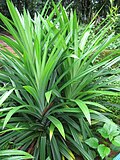Pandanus amaryllifolius: Difference between revisions
CSV import Tags: mobile edit mobile web edit |
CSV import |
||
| Line 26: | Line 26: | ||
{{stub}} | {{stub}} | ||
==Pandanus amaryllifolius== | |||
<gallery> | |||
File:Chottola.jpg|Pandanus amaryllifolius | |||
File:Sifon_pandan.JPG|Pandanus amaryllifolius | |||
File:Buko_Pandan_Salad_from_Beach_House_in_-CostaPacifica._-food_-baler_-aurora_-philippines_-travel.jpg|Buko Pandan Salad | |||
</gallery> | |||
Latest revision as of 04:12, 18 February 2025
Pandanus amaryllifolius is a tropical plant in the Pandanaceae family. It is commonly known as pandan, and is used widely in South Asian and Southeast Asian cooking as a flavoring.
Etymology[edit]
The name amaryllifolius refers to the amaryllis-like leaves of the plant. The term is derived from the Greek words amarysso (meaning "to sparkle") and folium (meaning "leaf").
Description[edit]
Pandanus amaryllifolius is a plant that grows in the wild and is also cultivated for its aromatic leaves. The plant is rare in the wild but is widely cultivated. It is a low, spreading plant with long, bright green leaves and woody aerial roots. The leaves are used for their scent in cooking and are also used in the formation of green color in dishes.
Culinary uses[edit]
In culinary terms, the leaves of Pandanus amaryllifolius are used in many Southeast Asian and South Asian cuisines. They are used to flavor rice and sweets, and are also used to make a type of tea. The leaves are also used as a wrapping for cooking food, and they impart a unique flavor and aroma to the dishes.
Cultivation[edit]
Pandanus amaryllifolius is propagated by cuttings. The plant prefers a sunny, well-drained position. It can be grown indoors in a pot, and should be watered regularly. The plant is frost-sensitive and should be protected from cold weather.
Medicinal uses[edit]
In traditional medicine, Pandanus amaryllifolius is used to treat a variety of ailments. The leaves are used to treat fevers, headaches, and stomach upsets. The roots are used to treat diseases of the skin.





